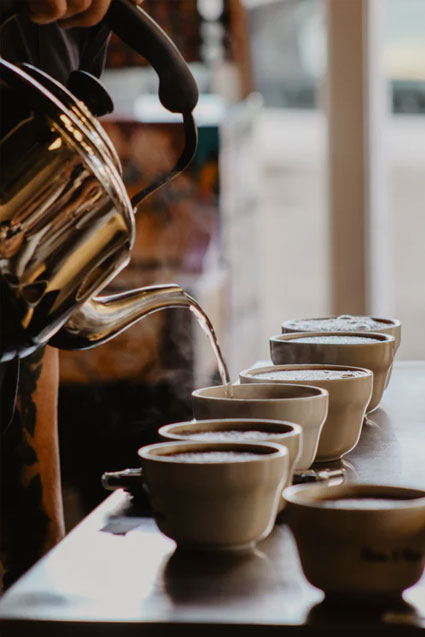Simple tips for aspiring coffee tasters

Mapping coffee aromas and flavors becomes a game.
As one travels the world of espresso or coffee in general, one's senses are endowed with different flavors and aromas. However, the more experienced we are at espresso, the more demanding we become, in the end - which is a positive and legitimate thing, as this is how we learn to distinguish good coffee.
Many times coffee flavors can be confusing to a beginner or even an advanced home barista - so here are some simple tips to make coffee tasting clearer and more fun, and to taste our palate in aromas and flavors.
Simple tips for aspiring tasters
 Makes sure your nose and mouth are "clean".
Makes sure your nose and mouth are "clean".
In many Italian espresso bars, it is common for espresso to be served with a small glass of sparkling water in order to "purify" our mouths and enjoy the aromas of coffee more. This little habit is indicative of the importance of our nose and mouth for the proper enjoyment of espresso.
In order to understand the full range of coffee aromas, it is necessary not to confuse its aromas with other strong scents. Spices, garlic, and even sweets can confuse the aromas and scents and deprive us of something to enjoy the coffee. Needless to say, although coffee and cigarettes were a popular combination in earlier times, cigarettes are one of the main enemies of coffee flavor, as they can significantly alter the taste profile of even the finest blend.
Pay attention to the smell, not just the taste
In order to grasp the flavor profile of our coffee to its fullest extent, it is a good idea to do a little "ritual" and pay attention, instead of drinking it in a hurry. This does not mean that we will repeat these steps every time we drink coffee, however, when we want to try something new or experiment, it is a good idea to follow in order to make our coffee more enjoyable.
Initially, we smell our roasted beans, and ground coffee - often, at this stage, the coffee has aromas that are quite different from those of the extracted coffee, which complement the overall experience. Then, we try to capture the scents that emerge during the extraction - this step is easier if we extract our coffee using the Pour Over method and a little more difficult in the case of espresso, where the extraction lasts for a few seconds.
After extraction, we serve the coffee and before the first sip, bring the cup to our nose, enjoying its final aroma. Then, we drink our coffee first with sharp cuts and then with larger sips, trying to perceive the taste differences in the tongue tip, back and palate.
 Enjoy your coffee plain and simple
Enjoy your coffee plain and simple
Naturally, our tasting of coffee is always done without the addition of sugar, milk, cinnamon, chocolate or sweeteners. Even if we prefer our sweet coffee, if we want to try a new coffee, it is right to drink it plain to emphasize its unique aromas. All kinds of accompanying cover the nature of the organoleptic characteristics of coffee and make it very difficult to evaluate. It goes without saying, of course, that when we try to map out the flavors of a new blend, we enjoy our coffee without snacks.
Read about different flavor profiles and stay informed
Many times, it is important to know what to expect from our coffee so that we can more easily identify differences in taste. Knowledge is gained on the one hand with experience and continuous testing, on the other hand reading is also important.
Initially, it is good to be aware of the taste differences of the coffee depending on the country of origin, and then we can go into more detail, such as how the height of the crop affects the taste and the processing of the coffee (washed or non-washed coffee). Finally, it is a good idea to have a look at the relevant terminology, understanding words such as acidity, body or intensity, as well as technical details, such as roasting.
Consult the "Wheel of Taste"
Although designed for professionals who use it in the cupping process, the flavor wheel is a simple tool that can be useful to amateurs as it gathers in simple and easy way the most flavors we can find in a cup of coffee. So we don't need to be professional to try to identify particular fragrances in our coffee - we can use the Wheel in a relaxed and stress-free way, exploring our coffee a little further.
Good coffee is no easy task - and training ourselves to really appreciate good coffee is an adventurous, long-lasting but definitely enjoyable journey, at the end of which we still have the coffee we deserve.








